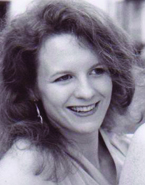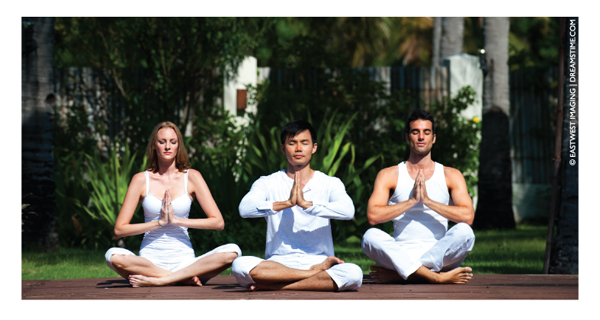Stretching It: An Englishwoman’s Search for American Spirituality
 A while ago, I started to wonder how my boyfriend and I could add a spiritual component to our relationship. As an Englishwoman living in the United States, I’m constantly trying to figure out how things are done here (it isn’t always as obvious as you might think). I’d come to realize that American relationships, like America’s individuals, are supposed to be spiritual. I just kept hearing that “s” word. Religious identification surveys and dating websites like Match.com even have a category for it: “Spiritual but not religious.” I didn’t understand what this meant. To me, the people who claimed to be spiritual just seemed like ordinary people, but an important immigrant trait is willingness to learn. So I persevered.
A while ago, I started to wonder how my boyfriend and I could add a spiritual component to our relationship. As an Englishwoman living in the United States, I’m constantly trying to figure out how things are done here (it isn’t always as obvious as you might think). I’d come to realize that American relationships, like America’s individuals, are supposed to be spiritual. I just kept hearing that “s” word. Religious identification surveys and dating websites like Match.com even have a category for it: “Spiritual but not religious.” I didn’t understand what this meant. To me, the people who claimed to be spiritual just seemed like ordinary people, but an important immigrant trait is willingness to learn. So I persevered.
I chose what seemed to me like a straightforward spiritualization method: a yoga and meditation retreat. My American guy, Mr. Fabulous, was enthusiastic, even recommending the perfect place. It was three hours from where we live and, to my surprise, he’d stayed there before. (This was unexpected. I hadn’t had him down as a yogic kind of guy. I’d been planning to improve him in that regard, and was uneasy to discover that he might be the one improving me.)
It turned out he had visited this retreat in the mid-1990s during the yoga center’s stricter incarnation: a time of no alcohol, no meat, and especially no sex, in accordance with the principles of its sacred founder. Imagine then, Mr. Fabulous recounted, warming to his story, the shock to the spiritual community when the sacred founder was discovered to have been practicing more than the plank pose with resident yoginis. There were other allegations besides. The center became embroiled in a class action lawsuit, and the guru was banished. (The yoga world is currently reliving this pain. Another guru, the creator of the international Anusara yoga empire, was accused in March of decidedly nonspiritual financial and sexual practices.)

“Last time I visited, there was a weird, unhappy undercurrent,” Mr. Fabulous said. “I got the most screwed-up massage I’d ever had from this guy who couldn’t stop talking about what had gone down with the yogi. I’d have told him to shut up but he was too wounded and grief-stricken.”
To us, the story was light relief, just one more piece of evidence that many leaders lack bodily discipline, a truism that applies whether their ultimate spiritual calling is Christianity or Congress, yoga, golf, or governorship. Judging from the center’s website, it had recovered from that instance of guru corruption, partly by going mainstream. There was no longer any active discouragement of sex or wine. The dining room offered chicken and fish to those who wanted it. In the old days, the place was a religious order, with all the potential for hubris and schadenfreude that brought. Now it was a pleasant yoga hotel.
I was happy the place had endured such pain and emerged stronger for it—I had a sense that this was part of what spirituality is about, along with learning from experience (the so-called “spiritual journey”). Generally, though, my attempt to define spirituality hadn’t been going well. There seemed shame in even asking what it was (like with orgasm: if you had to ask, you hadn’t experienced it). I ran into spiritual quotations on refrigerators, T-shirts, bumper stickers, and Facebook updates. I was startled to read self-congratulatory spiritual blogs (implicitly more spiritual than thou), and to see a lipstick promoted as spiritual because it contained St. John’s Wort. Spirituality seemed linked to the ubiquitous arguments that “everything happens for a reason,” “what doesn’t kill you makes you stronger,” and “what goes around comes around” (if we can call these arguments). Its ascendency was commonly attributed to both affluence and the recession.
For me, the evidence converged on one conclusion: the basic human need to identify ourselves as decent people. “Spirituality” seemed a self-acknowledgement of any public-spirited or philanthropic impulse, any claim to wisdom or the experience of hardship. In clunkier terms, my thoughts are better than your thoughts. Among flakier types, it apparently described any redeeming feature whatsoever. (So if you’ve never tortured a kitten, you’re spiritual?)
At least Mr. Fabulous and I didn’t have to worry about whether we qualified. So to the yoga center we went.
I figured spirituality must start with self-awareness. The initial evidence, however, wasn’t encouraging. For example, although competition is non-yogic, I couldn’t help noticing that I took six yoga classes in those three days, while Mr. Fabulous only took one. Nor could I help noticing that I got up at 6 a.m. to practice while Mr. Fabulous stayed in bed. And while I’m aware that smugness and disapproval are the antithesis of spirituality, I couldn’t help but feel them anyway.
Obviously I needed to work on my personality. I took Mr. Fabulous to an art workshop involving crayons, markers, and pictures cut from magazines. Most of the participants created artworks—some quite lovely—involving flowers, rivers, rainbows, hearts, or words (“CONFIDENCE,” “TRUTH,” “WORK,” “LOVE,” “YES!”). Everyone, it seemed, had used this opportunity to experience some kind of spiritual breakthrough.
Well, not quite everyone.
My artwork was a collage: cut-outs of toned women in perfect yoga poses. I knew exactly what insight this offered into my authentic soul. “I just want to look like them,” I whispered to Mr. Fabulous. He had scribbled a dark, dripping figure that seemed to be holding a gun.
Evidently spirituality was more elusive than we’d realized. We went to the dining room and ate lentil loaf. Mr. Fabulous raked through his memories of American culture, I dusted off my history degree from a couple of decades ago, and together we drafted our thesis on the emergence of the contemporary spirituality movement. It took five minutes and went something like this: In the beginning, needless to say, were the 1960s. The ’60s and ’70s were when many movers and shakers read The Little Prince, The Prophet, and later Jonathan Livingston Seagull. These books are much shorter than the Bible. They don’t require you to do anything other than understand that the picture is not of a hat but of a snake that swallowed an elephant, and that at your wedding you should say something about spaces in your togetherness. So that’s what we all did. Then we got into addiction recovery and started saying the Serenity Prayer. We went into therapy and worked on self-justification. And then, as we became more affluent and loaded up on birth control pills and antidepressants and all the new stuff we could buy, we realized that practicing a religion was hard. Religion involves rules, actions, and self-deprivation.
With spirituality, in contrast, you needn’t do anything other than announce you have it. You needn’t agonize over the fact that your preacher pocketed the profits or that your priest turned out to be a pedophile. Another benefit: spirituality seemed connected to a harmonious vibe that Mr. Fabulous and I were finding the most compelling feature of our yoga retreat.
“But you know why that is, don’t you?” said Mr. Fabulous, confidingly, over the lentil loaf. “It’s because 90 percent of the people here are women.”
“Oh, but there are lots of men,” I started to say, glancing around the dining room. But there were not lots of men. Scattered around, the few men looked more numerous than they were. That’s what men do when they’re outnumbered: they add up to more than the sum of their parts.
“Notice,” said Mr. Fabulous. “No one’s loud, drunk, vomiting, showing off, fighting, or being arrested.”
This was certainly true. Not one woman was loud, drunk, vomiting, fighting or being arrested. (I wasn’t entirely sure about showing off. Who’s to say all those slippery yoginis in my dawn class hadn’t a show-offy thought in their heads? But I gave them the benefit of the doubt.) Mr. Fabulous could make generalizations about men that, coming from me, would sound like the ravings of a militant harpy. He, however, seemed nothing but reasonable. He told me he’d realized around age twenty that sexism and racism were the main issues—nothing else came close—and had spent his subsequent decades having that impression confirmed again and again.
But this was no time to congratulate myself on finding a man like this. It was a time to consider the behavior of the women around us, which was less about their mystical qualities, I reluctantly decided, than their underlying good sense.
Mr. Fabulous asked what I would do with my picture from the workshop. I had the impression we were expected to keep our artworks and refer to them on our lifelong spiritual paths. I supposed I could stick mine on the refrigerator as a reminder not to eat the ice cream. Actually, I just wanted to throw it away, but that seemed so wrong. I stared at my lentil loaf and laid down my fork, realizing how completely I was failing.
Please know that I have nothing against yoga, meditation, retreat centers, or exploratory workshops. I’m willing to believe that there are people who can explain spirituality as something specific and important; something different from the human traits for which we already have words—like kindness, thoughtfulness, and maturity; perhaps a means of truly looking beyond oneself. If I had found those people, this would be a different story. In the meantime, Mr. Fabulous and I sat in the dining hall among all the women, and I considered my glutes and the fabulous things that yoga can do for the body.
